The Nagasaki Atomic History and the Present (NAHP) website is an online educational resource intended for American high school and college students to learn about the atomic bombing of Nagasaki, Japan, and consider what the effects of a nuclear weapon on their hometowns might be. NAHP is the result of a summer 2016 collaboration at Colgate University between Aleksandr Sklyar (Colgate ’10), Georgia Butcher (Colgate ’17), and Benjamin Kelsey (Colgate ’18) made possible by Prof. Karen Harpp (Colgate University, Geology and Peace and Conflict Studies) and undergraduate summer research opportunities. A close-knit network of IT, communications, and video specialists at Colgate University were instrumental in the creation of NAHP. Please see Acknowledgments and Credits for a complete list of funding sources and all those who helped us along the way.
Please contact asklyar@umich.edu with any questions or comments.
Below is a project statement and synopsis, penned by Benjamin Kelsey (Colgate ’18).

In photo: Georgia Butcher (Colgate '17), Benjamin Kelsey (Colgate '18), and Aleksandr Sklyar (Colgate '10)
NAHP: The Stories of Nagasaki, Reverberating in the Present
by Benjamin Kelsey (Colgate '18)
When it comes to atomic bombs, Nagasaki is often thought of as a second city. It was the second city chronologically to be bombed using atomic weapons. It is often thought of second when the subject of peace activities comes up. It is also a city of two faces, of two histories: in addition to having been the victim of an atomic bombing, it has a history as the only port through which the outside world could trade with Japan. From its Chinatown, to its Catholic Cathedral, to its cuisine, it still retains much of the foreign influence that came with trade. Because of this, it has tended to be split in comparison with Hiroshima. While the latter dedicates itself wholeheartedly to its mission as a city of peace, Nagasaki sees itself occupying multiple positions. The result of this second-city status is that it is often overlooked in materials and resources on atomic bombs. There is a dearth of content about it, and this only serves to further isolate it from its connection to those weapons. We embarked on this project in part to attempt to remedy this situation, to provide a place for students to find information about the atomic bombing of Nagasaki, and to provide educators with resources to teach them.
This lack of resources is compounded by the narrative of the bombs that seems pervasive in U.S. high school and college history classes. For lack of time or lack of opportunity, a nuanced and complete account of the environment and process surrounding the bombs is not present in most classes, and what information there is tends to focus on the U.S. and ignores the physical and human effects of atomic weapons. Additionally, there is a lack of information on the current status of nuclear weapons. These are the issues that we have sought to tackle.
To this end, we have created a website to act as an educational tool accessible to as many students and teachers as possible that contains original first-person accounts of survivors, peace activists, politicians, educators, and more. We watched and edited over 11 hours of Japanese footage into videos by person and by theme, adding images, text, and other footage where appropriate to improve comprehension and interest. With the help of over 30 volunteers, we transcribed and subtitled the resulting videos, and made the products available on our website. Drawing on our individual knowledge and research, we also produced a number of guided paths for students to learn about the subject of our website, as well as lesson plans for teachers to use as supplemental materials for their classes, complete with introductions, schedules, and project ideas. All of this original content was created by our team, and is openly available on the website. We have also created a section of the website that contains a curated list of external resources for students and teachers to use, broken down into online sources that anyone can access and online or print resources that may require a library database subscription to access. One main example of such a resource is a program called NUKEMAP that can be used to simulate the effects of nuclear weapons of various strengths anywhere in the world, complete with estimates of casualties and damage to infrastructure. Through NUKEMAP, in particular, we hope to make the experience of an atomic bombing more tangibly imaginable for students.
To house our content, we enlisted the help of the Colgate ITS and Library staff to produce a website that is hosted on the Colgate servers. We built the paths, pages, and posts that contain the text, images, and videos that are featured on the website. Its structure is designed to provide robust organization while ensuring that navigation is easy. We feel that teachers and students want to be able to access information quickly and to not have to sort through lengthy lists of content. We have therefore organized our content into distinct units and pages so that users can choose what they want to see and navigate to it from anywhere on the website. Ease of navigation is something that we saw lacking on other educational websites, so it was one of our priorities. We also strove to produce a website that was visually inviting so that teachers and students would want to use it. We sought simplicity and legibility in the website’s design.
What we have produced is a resource for everyone. It is the product of many hours of work, and we believe that it achieves much of what we set out to do. It has received the constructive input of a large group of professionals across its many facets, including educators, video editing experts, copyright specialists, and website managers, and has thereby been shaped into the resource it is today.
